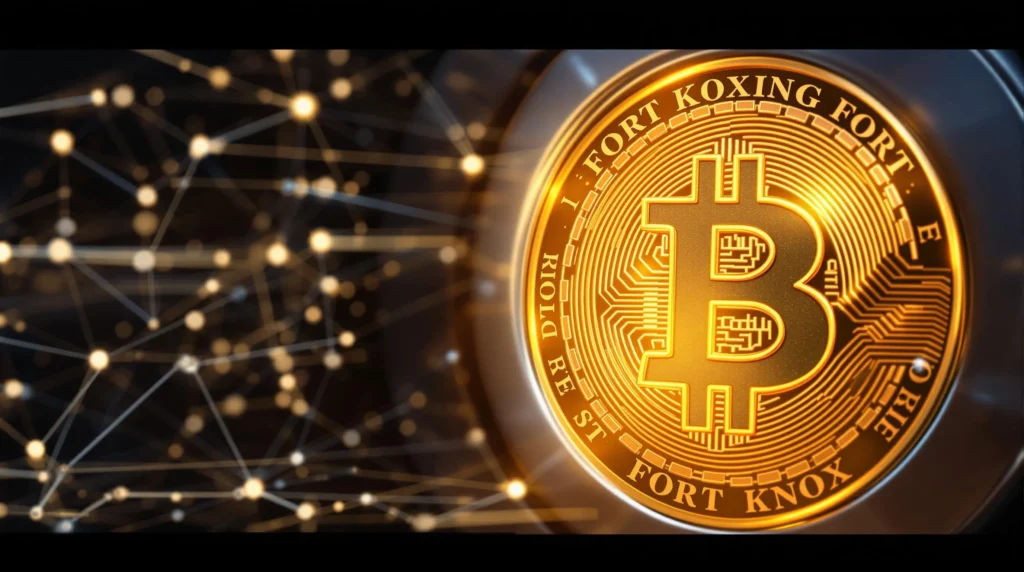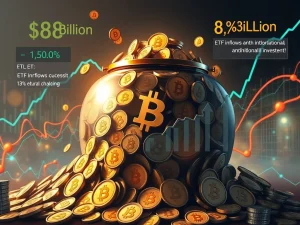Bitcoin vs. Fort Knox: Unveiling Why Bitcoin’s Transparency Shines Brighter Than Gold

In a world grappling with financial uncertainty, the quest for secure and trustworthy assets has never been more critical. Senator Rand Paul’s recent call for an audit of Fort Knox’s gold reserves has ignited a fascinating debate: Is traditional gold, locked away in vaults, truly the pinnacle of financial security, or is there a new contender on the horizon? Enter Bitcoin, the digital gold, challenging the age-old dominance of precious metals. This isn’t just about comparing assets; it’s about understanding the fundamental shifts in how we perceive value, security, and, most importantly, financial trust.
Fort Knox Gold Under Scrutiny: A Need for Transparency
Fort Knox, the legendary vault housing a significant portion of the United States’ gold reserves, has long been a symbol of impenetrable security and unwavering value. However, Senator Rand Paul’s recent proposition for a comprehensive audit has cast a spotlight on the inherent opacity of this system. Why the call for an audit now? Concerns about the actual quantity and condition of the gold reserves, coupled with a growing demand for greater governmental transparency, are fueling this movement. For decades, the contents of Fort Knox have largely been a matter of faith, with limited independent verification. This reliance on trust, without concrete proof, is increasingly questioned in an era demanding accountability.
Consider these points regarding the challenges surrounding Fort Knox gold:
- Lack of Regular Audits: Unlike publicly traded companies that undergo routine financial audits, Fort Knox’s gold reserves are not subject to regular, independent verification. This absence of consistent oversight creates an environment of uncertainty.
- Historical Skepticism: Whispers and theories about the true state of Fort Knox’s gold have circulated for years. While these remain largely unsubstantiated, the lack of definitive audits allows such speculation to persist.
- Physical Verification Complexities: Auditing physical gold reserves is a complex and costly undertaking. It involves meticulous procedures to verify the weight, purity, and authenticity of each bar, adding to the reluctance for frequent audits.
- Opportunity Cost: Gold stored in Fort Knox is essentially inert. It generates no yield and incurs storage and security costs. In a dynamic financial landscape, the opportunity cost of holding vast reserves of unproductive gold is a growing concern.
Bitcoin: A Beacon of Transparency in the Digital Age
In stark contrast to the opaque nature of Fort Knox, Bitcoin operates on a foundation of radical transparency. Every transaction, every Bitcoin in existence, is recorded on a public, immutable ledger – the blockchain. This inherent transparency is not just a feature; it’s a core tenet of Bitcoin’s design, fostering a level of financial trust rarely seen in traditional systems. Anyone, anywhere in the world, can independently verify the Bitcoin supply and transaction history, without relying on intermediaries or central authorities.
Let’s delve into how Bitcoin achieves this unparalleled transparency:
- Public Blockchain: The Bitcoin blockchain is open and accessible to all. Block explorers allow anyone to view transaction details, wallet balances, and the overall network activity in real-time.
- Decentralized Ledger: No single entity controls the Bitcoin blockchain. It is maintained by a distributed network of nodes, making it resistant to censorship and manipulation. This decentralization is key to its trustworthiness.
- Cryptographic Verification: Transactions are secured using advanced cryptography, ensuring their authenticity and preventing double-spending. This cryptographic security underpins the integrity of the entire system.
- Open-Source Code: Bitcoin’s underlying code is open-source, meaning it is publicly auditable. Developers and researchers worldwide can scrutinize the code, identify vulnerabilities, and contribute to its ongoing improvement.
Why Bitcoin is Emerging as a Superior Alternative to Fort Knox Gold
The debate isn’t merely about physical versus digital; it’s about fundamental advantages that Bitcoin offers over traditional gold, particularly in today’s interconnected and technologically advanced world. While gold has served as a store of value for millennia, Bitcoin presents a compelling case for being a more effective and future-proof alternative. Let’s explore the key areas where Bitcoin surpasses Fort Knox gold:
| Feature | Fort Knox Gold | Bitcoin |
|---|---|---|
| Transparency | Opaque, limited audits, reliance on trust | Radically transparent, public blockchain, verifiable supply |
| Accessibility | Inaccessible, physically stored, centralized | Globally accessible, digital, decentralized |
| Portability | Difficult to transport, physical limitations | Easily portable, digital, borderless |
| Divisibility | Divisible, but physical constraints | Highly divisible (down to satoshis), flexible transactions |
| Verifiability | Requires physical audit, complex verification | Easily verifiable on the blockchain, cryptographic proof |
| Security | Physical security, centralized risk | Cryptographic security, decentralized network, self-custody options |
The Power of Digital Scarcity: Bitcoin’s Edge Over Physical Gold
While gold’s scarcity is a natural phenomenon, Bitcoin’s scarcity is mathematically enforced and transparently verifiable. The 21 million Bitcoin supply cap is hardcoded into its protocol, ensuring digital scarcity that cannot be altered. This predictable and limited supply contrasts with the potential for new gold discoveries and mining advancements, which could, in theory, impact gold’s scarcity over time. Financial trust in Bitcoin is further strengthened by this pre-defined scarcity, as it removes the uncertainty associated with fluctuating supplies.
Consider these aspects of Bitcoin’s digital scarcity:
- Fixed Supply Cap: The 21 million Bitcoin limit is immutable, programmed into the Bitcoin protocol from its inception. This creates predictable and verifiable scarcity.
- Deflationary Nature: With a limited supply and increasing adoption, Bitcoin exhibits deflationary characteristics, potentially increasing its purchasing power over time.
- Programmatic Scarcity: Bitcoin’s scarcity is not based on geological limitations but on cryptographic and mathematical principles, making it a truly digital form of scarcity.
- Transparent Supply Schedule: The rate of new Bitcoin issuance is also pre-programmed and publicly known, further enhancing transparency and predictability.
Embracing the Future of Finance: Bitcoin as a Modern Store of Value
The world is rapidly digitizing, and our financial systems are evolving alongside. Bitcoin, born from the digital age, is uniquely positioned to serve as a modern store of value for the 21st century. Its transparency, accessibility, portability, and verifiable scarcity align perfectly with the demands of a globalized and technologically driven economy. While Fort Knox and gold represent a legacy system rooted in physical constraints and opaque processes, Bitcoin offers a glimpse into a future where financial trust is built on transparency, cryptography, and decentralized networks.
In conclusion, Senator Rand Paul’s call for a Fort Knox audit has inadvertently highlighted a crucial point: the world is demanding greater transparency and accountability in its financial systems. Bitcoin, with its inherent transparency and digital nature, offers a compelling alternative to traditional gold. As we move forward, the conversation is shifting from blind faith in legacy systems to informed trust in transparent, verifiable, and digitally native assets like Bitcoin. The future of finance is unfolding, and Bitcoin is undeniably at the forefront, challenging the status quo and illuminating a path towards a more transparent and accessible financial world. It’s time to consider: is Bitcoin not just ‘fixing’ finance, but also redefining what we consider to be true value in the digital age?









